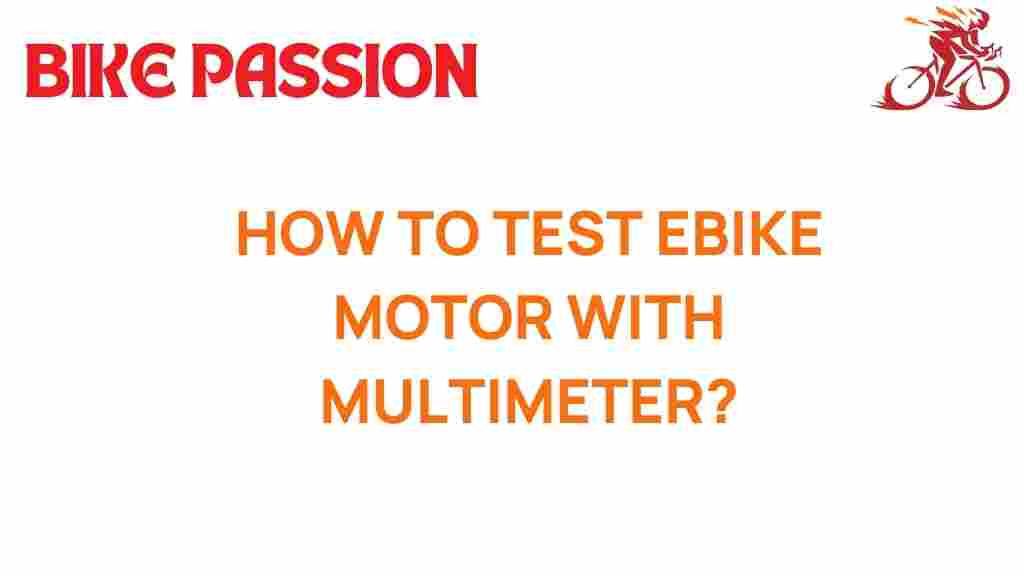Unraveling the Mystery: Testing Your eBike Motor with a Multimeter
Electric bikes, or eBikes, have revolutionized the way we commute, offering a blend of convenience and eco-friendliness. However, like any machine, the eBike motor can encounter issues that affect performance. Regular maintenance and troubleshooting are essential to keep your electric bike running smoothly. One of the best tools at your disposal for diagnosing problems is a multimeter. In this guide, we will explore the process of testing your eBike motor with a multimeter, enabling you to perform effective diagnostics and maintenance.
Understanding Your eBike Motor
Before diving into the testing process, it’s important to understand the components of your eBike motor. Most eBikes use one of three types of motors: hub motors, mid-drive motors, and friction drive motors. Each type functions differently and may require specific testing methods.
- Hub Motors: Located in the wheel hub, they provide direct power to the wheel.
- Mid-Drive Motors: Positioned near the bike’s pedals, they utilize the bike’s gears for improved efficiency.
- Friction Drive Motors: These motors press against the tire and are less common.
Understanding the type of eBike motor you have will aid in effective troubleshooting and maintenance.
Step-by-Step Guide to Testing Your eBike Motor with a Multimeter
Now that you have a basic understanding of your eBike motor, let’s move on to the testing process. Follow these steps to test your eBike motor using a multimeter:
What You Need
Before starting, gather the following tools and materials:
- A multimeter: Essential for measuring voltage, current, and resistance.
- Basic tools: Screwdrivers, wrenches, and pliers for disassembly.
- Safety gear: Gloves and safety glasses.
1. Safety First
Always prioritize safety when working with electrical components. Disconnect the battery from your eBike to prevent any accidental shocks or shorts during testing.
2. Inspect the Motor Visually
Before using the multimeter, perform a visual inspection of the eBike motor:
- Check for any visible damage, such as cracks or corrosion.
- Ensure that all connections are secure and free of debris.
- Look for signs of wear on the wiring and connectors.
3. Testing Voltage
To test the voltage of your eBike motor:
- Reconnect the battery to the eBike but ensure the motor is still disconnected.
- Set your multimeter to the DC voltage setting.
- Attach the multimeter probes to the motor’s power terminals.
- Power on the eBike and check the voltage reading.
A normal reading should be close to the battery voltage. If the reading is significantly lower, it may indicate an issue with the battery or wiring.
4. Testing Current
To test the current flowing through the motor:
- Disconnect the battery again for safety.
- Set the multimeter to the DC current setting.
- Connect the multimeter in series with the motor by disconnecting one of the motor wires and connecting it to one probe of the multimeter, while the other probe goes back to the battery.
- Reconnect the battery and power on the eBike.
Check the current reading. If it’s too high or too low, there may be a problem with the motor or controller.
5. Testing Resistance
Resistance testing helps determine if the motor windings are intact:
- Turn off and disconnect the battery.
- Set the multimeter to the resistance (ohm) setting.
- Place the probes on the motor terminals.
- Check the reading; it should be within the manufacturer’s specified range.
High resistance could indicate a broken winding, while low resistance may signify a short circuit.
6. Check the Controller
Sometimes, issues may arise from the controller rather than the eBike motor itself. To test the controller:
- Use the multimeter to check the voltage output from the controller while the bike is powered on.
- Compare the readings with the specifications in your eBike manual.
Any discrepancies might indicate a faulty controller that requires replacement.
Troubleshooting Common eBike Motor Issues
After testing your eBike motor, you may encounter specific problems. Here are some common issues and their potential solutions:
1. Motor Not Responding
If your eBike motor is unresponsive:
- Check the battery charge and connections.
- Inspect the wiring for any visible damage.
- Test the controller as described above.
2. Weak Performance
If the motor runs but lacks power:
- Verify the battery voltage and current output.
- Check for any mechanical binding in the drivetrain.
- Ensure the motor is properly calibrated according to the manufacturer’s guidelines.
3. Unusual Noises
If you hear grinding or unusual noises from the motor:
- Inspect for foreign objects lodged in the motor or wheel.
- Check the bearings and gears for wear or damage.
- Lubricate moving parts if necessary.
4. Overheating
If the motor overheats during operation:
- Ensure that the motor is not overloaded or working against too much resistance.
- Check for proper ventilation and cooling mechanisms.
- Inspect for short circuits that may cause excessive current flow.
Conclusion
Testing your eBike motor with a multimeter is an invaluable skill for maintaining your electric bike’s performance and longevity. With the right tools and knowledge, you can diagnose and troubleshoot many issues that may arise, allowing for effective DIY repairs. Regular maintenance not only enhances the performance of your eBike but also ensures a safer and more enjoyable riding experience.
If you want to learn more about electric bike maintenance, check out this comprehensive guide. For more technical resources on eBike components, visit the official eBike resource center.
By following the steps outlined in this article, you can keep your eBike in top condition and enjoy many miles of trouble-free riding!
This article is in the category Maintenance and created by BikePassion Team
